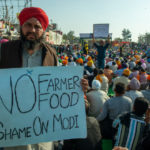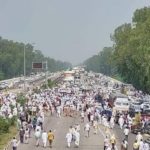Summary: Analyses the November 26 and December 8 strikes by 250 million farmers and workers, the largest anywhere in the world — Editors
As estimated 250 million workers in India carried out a successful general strike action on the 26th of November 2020. This general strike was called and supported by all the major trade union federations along with many independent trade unions. The list includes the Centre of Indian Trade Unions (CITU), New Trade Union Initiative (NTUI), All India Central Council of Trade Unions (AICCTU), Trade Union Centre of India (TUCI), All India Trade Union Congress (AITUC) among many others[i]. The main demands for the strike were multiple, as the Times of India reports:
- Withdrawal of all “anti-farmer laws and anti-worker labour codes”
- Payment of Rs 7,500 in the accounts of each non-tax paying family
- Monthly supply of 10 kg of food grains to needy families
- Mahatma Ghandi National Rural Employment Guarantee Scheme expansion to give 200 workdays every year, higher wages and the scheme’s implementation in urban areas
- Stop “privatisation of the public sector, including the financial sector, and stop corporatisation of government-run manufacturing and service entities like railways, ordinance factories, ports etc.”
- Withdrawal of the “draconian circular on forced premature retirement of government and PSU employees”
- Pension to all, scrapping of NPS (National Pension System) and the reimposition of earlier pension with improvement in EPS-95 (Employees’ Pension Scheme-1995 run by retirement fund body EPFO)[ii]
The 26th November General Strike was one of the largest and most massive united working-class strike actions the nation has witnessed since Hindu nationalist and neofascist Narendra Modi came to power in 2014. In recent times, the central trade unions in India have been carrying on successful strike actions annually against the Modi led central government, sometimes unitedly while at times individually. The recent one was taken up in a context when the electoral left in the country had witnessed a slight resurgence in the state of Bihar[iii]. However, two of the three main traditional bastions of the left in the country- West Bengal, Kerala and Tripura- are yet to witness any significantly sustained movement focused on the demands. In spite of the lack of sustained social movement support for the demands raised by 26th November General Strike, their importance cannot be denied, given that in the coming period many states, including West Bengal, will be holding elections. At the same time, it must be noted that the conversion ratio of striking workers and farmers to the vote share of the left has not been a sight of much hope for the left in recent history.
Importantly, the 2020 General Strike in India was one of the few united declarations made by the central federation of trade unions, which had garnered support from almost all the tendencies and currents of the left in the country, including tendencies which have been opposed to one another, even on a Common Minimum Program basis, since time immemorial. Along with the General Strike, there was, and is, the simultaneous agitation of the Indian farmers in Delhi, which has shaken the ruling fascistic government of India. On the 25th of November, the farmers of Haryana broke the barricades installed by the central government and state police forces and marched ahead towards the capital[iv]. In some ways, this was the first event which pre-anticipated what would turn out to be an iconic day in recent working-class movements of the country, especially since the Bombay strikes of 1982-83[v].
After the successful general strike of 26th November, the farmers, led partially by the All India Kisan Sangharsh Co-ordination Committee (AIKSCC), with involvement from major left-wing farmers’ and peasants’ organisations, urged civil society and the trade unions to support their call for another All India General Strike on the 8th of December[vi]. In recent history, it had become almost farcical to expect the country to support two general strikes within a span of two weeks. But much to the pleasant surprise of activists and academics aligned with the left, the 8th of December Strike went ahead successfully with massive support[vii].
The farmers have made significant additions to their initial demands, which now include the demand to free all intellectual and political prisoners in India[viii]. The ongoing farmers’ agitation in Delhi is currently witnessing support from all the major and minor left-wing student organisations in the and socialist women’s organisations. The farmers’ movement has support coming in from the Indian diaspora located in the US, Canada, UK, New Zealand, and Australia among others, in addition to gaining support in the form of solidarity statements from left wing- parties and organisations globally. One of the reasons for this can be ascribed to the massive participation of the farmers from Punjab and Haryana, who form a significant part of the diaspora in countries like Canada and the UK, the historically popular sites of emigration from the subcontinent especially for the people from Punjab and Haryana.
It would be premature to label the recent events in India as revolutionary per se because in a country as diverse as India, it could be only a matter of days when the movement becomes disorganised and splinters along different paths as has been the case in the past. There is of course, a very distinct class character of these movements with regard to the involvement of the different sections of the working class and peasants of the country, which needs a far lengthier analysis than space permits here. However, it cannot be denied that these movements, hold immense revolutionary potential with the onus now on the political, activist and academic left to shed their social and class privileges and ensure that the movement retains its spontaneous character and does not fall prey either to the opportunism of the petty-bourgeois liberal current within the Indian political scenario or to the fascistic politics of fear of the ultra-right. This can only be done if the left is with the struggling people, and not with only their cadres and leaders.
Footnotes
[i] The full declaration is available at http://citucentre.org/687-central-trade-unions-and-independent-federations-declare-nationwide-general-strike-on-26-november-2020
[ii] Source: https://www.timesnownews.com/india/article/26th-november-2020-strike-10-trade-unions-call-for-nationwide-bandh-autos-cabs-in-telangana-to-join-strike/685445
[iii] See https://imhojournal.org/articles/bihar-elections-in-india-the-route-for-resurgence-of-the-left/
[iv] See https://indianexpress.com/article/india/farmers-protest-water-cannons-delhi-chalo-haryana-7066359/
[v] See https://en.wikipedia.org/wiki/Great_Bombay_textile_strike
[vi] See https://www.business-standard.com/article/current-affairs/political-parties-other-groups-support-farmers-bharat-bandh-on-dec-8-120120600648_1.html
[vii] See https://thewire.in/politics/interview-cpi-ml-liberation-leader-dipankar-bhattacharya-farm-laws-bihar-bengal-elections
[viii] See https://economictimes.indiatimes.com/news/politics-and-nation/protesting-farmers-add-new-demands-to-list-govt-says-movement-hijacked-by-ultra-left/articleshow/79703983.cms





0 Comments